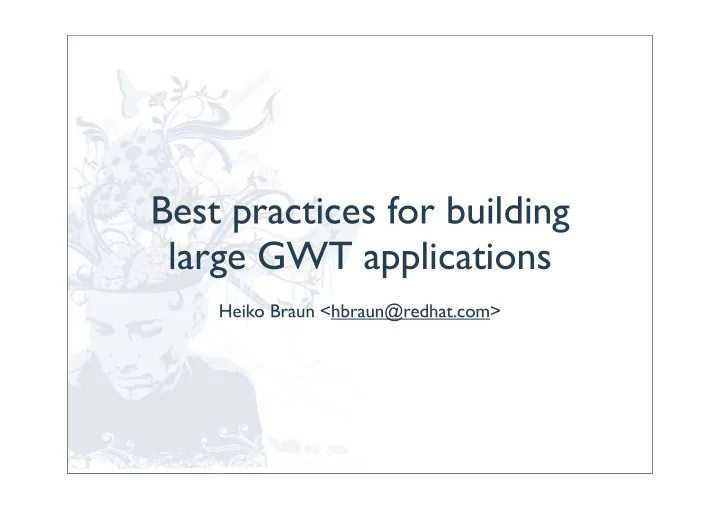

Best practices for building large GWT applications Heiko Braun <hbraun@redhat.com>
About me • Heiko Braun • Senior Software Engineer JBoss / Red Hat • 4 years JBoss, 12 years industry • Focus on SOA, BPM, GWT • Contributor: JBossWS, jBPM, Riftsaw, Errai, SAM, Savarra > http://jboss.org
Topics • What is GWT? • Decomposing a large GWT application • Introducing project Errai
What is GWT?
Google Web Toolkit • Write AJAX apps in the Java language, then compile to optimized JavaScript • SDK: API, Compiler, Hosted Mode Browser • Edit Java code, then view changes immediately without re-compiling • Step through live AJAX code with your Java debugger • Compile and deploy optimized, cross-browser JavaScript > http://code.google.com/webtoolkit/
GWT Features • Communicate with your server through really simple RPC • Reuse UI components across projects • Use other JavaScript libraries and native JavaScript code • Localize applications • Choice of development tools • Test your code with JUnit • Open Source
Decomposing large GWT applications
Example: JBoss SOA tooling
Challenge #1:Feature Set • Different features per: • Target runtime • Development stage • Project lifecycle • Target audience
Solution #1: Compile-time composition • Leverage Maven dependency sets • Using Deferred Binding • Create and select a specific implementation of a class • Either using Replacement or Generators
Solution #1: Compile-time composition (1) ‘mvn -Dconsole.profile=drools install’ (2) Properties file or annotations (3) Deferred Binding Generator
Limitation #1: Component interplay • Each plugin component isolated • No interplay possible • It would introduce dependencies • Grouping by functionality vs. usability • Conceptual split not necessarily technical split
Challenge #2: Coupling between components
Challenge #2: Coupling between components • Components “decorate” functionality • i.e. Process Management & Reporting • Dependencies may come and go • Different feature set: - Maturity (CR vs. GA) - Environment (staging vs. production) - Profiles (custom composition)
Solution #2: MVC • (1) Model changed Model-View-Controller ? • Less coupled • Still compile-time dependencies (2) Update View
Solution #2: Pub/Sub (1) Publish messages • Messaging through publish / subscribe • Messaging API only shared dependency • Notion of “presence” (2) Subscribe Listener
Limitation #2: Pub/Sub • Decoupling through de-typed nature • No compile-time checking • Exchange protocol (contract) not “visible” • Choreography validation?
Challenge #3: UI Components coupled to services • I.e. Email client requires SMTP service • Services may come and go: • SOA promise • Different product versions • Target runtime derivations
Solution #3: Bootstrap • Bootstrap: “Give me a list of (1) Client UI starts, request server status capabilities” • Usually RPC call when app starts • Problem: Fixed initialization point • Lazy Components? (2) PluginInfo (type, available)
Solution #3: Messaging w. Presence • Presence: “Need a plumber. Please call XYZ” • Relies on messaging bus behind the scenes • Async, independent, durable (1) Client: Seek capability (2) Provider: Offer capability
Introducing Project Errai
Project Errai • Consolidates JBoss GWT efforts • Tackles the problems described earlier • Both R&D and actual product development • Main components: • Message Bus, Workspace framework, Widget library > http://jboss.org/errai
Errai-Bus • Backbone to application design • Common architecture across client&server • Enables federated architecture • Asynchronous messaging (pub/sub) • Conversational • Both GWT and Javascript API (OpenHub Spec)
Errai-Bus API: Common to client & server (1) Client: Publish (2) Server: Subscribe
Pub/Sub roles vs. tiers • client-client across server (chat server) • client-client w/o server (inter component) • client-server (client send) • server-client (server push)
Workspace framework • UI environment for which to deploy your console • Provides development infrastructure, documentation and examples: - Tear down barriers, ease of use • Common, shared services, i.e: - Authentication & Authorization - Logging & Exception handling • Allows toolset composition at various stages: - Sandbox, Project, Product
Workspaces API • Handles loading, initialization and access to tools • Uses Deferred Binding as well (1) Component declaration (2) Automatic workspace assembly
Errai Widgets • Complements OSS offering (i.e. Mosaic)
Putting it all together • Baseline for JBoss SOA tooling • Free composition of console components • Different projects provide management tools • Mix and match with 3rd party elements
Demo Applications
Q&A > http://jboss.org/errai > http://errai-blog.blogspot.com/
Recommend
More recommend